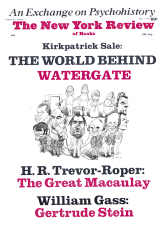A creative and committed teacher (see 36 Children), Kohl believes that “anyone who reads with a certain degree of competency can help others who read less well.” He addresses this book more to those involved in tutoring programs and alternative schools than to professional reading teachers. He suggests that anyone can learn to read if allowed to develop basic skills at his own rate. He has no use for standardized tests or for the competition and approval-seeking inherent in the traditional classroom approach. Instead of looking to grade levels or test scores, he divides the reading skill into four stages of achievement—“beginning,” “not bad,” “with ease,” and “complex” (for each reading stage there are word games, writing exercises, and recommended books)—and he provides extensive suggestions about approaches and materials likely to be useful at each stage, without dictating curriculum or methodology but merely sharing ideas that have served him well.
In fact, Kohl’s lack of dogmatism is almost dogmatic, a trait that may lead some professional educators to write him off as a laissez-faire fanatic. This would be unfortunate since his approach has as much to offer in the public school classroom as it does in the remedial reading clinic. Anyone interested in teaching children to read has something to learn from this book.
In his visits to the Middle East since the 1967 June War, David Pryce-Jones, a British journalist and novelist, has seen a great many Palestinian refugee camps in Jordan, Syria, and on the West Bank. He finds them generally decent places—indeed the nonrefugee poor often try to get into them. Conditions in the camps have tended to improve in the past few years and many refugees have entered the labor force. Pryce-Jones also examines the political mechanisms of Israeli occupation, especially the courts and prisons. He concludes that the reports of torture tend to reflect the Arab’s lack of respect for fact (as well as that “the Westerner too is stuck with the stories he is told and those he tells himself”). The Arabs were doubly humiliated when the Israeli occupiers turned out to be something less than fiends, and Pryce-Jones describes a kolubuja (“everything hurts”) syndrome which “the bedside manner of the foreigner tends to bring out” in the Arabs. The fact of life on the West Bank is a “slippery and unwilling slide into toleration,” which has unmanned the fedayeen resisters’ popular base.
Pryce-Jones has little to say about the 1970 Jordanian civil war apart from its further weakening of the fedayeen, and he loftily dismisses the political differences within the Palestine liberation movement. But the book’s strength is not developed analysis but description of an exceptional sort—Pryce-Jones’s unostentatious learning, his fine prose, and his broad sympathies (though his conclusions seem pro-Israel, he is far from being an uncritical partisan) make this one of the most distinguished books on the recent history of the region.
(Notice in this section does not preclude review of these books in later issues.)
This Issue
May 3, 1973



